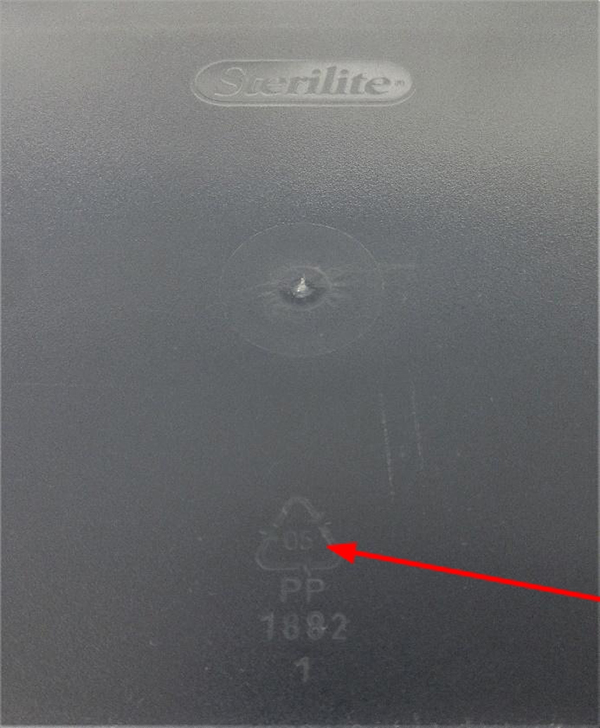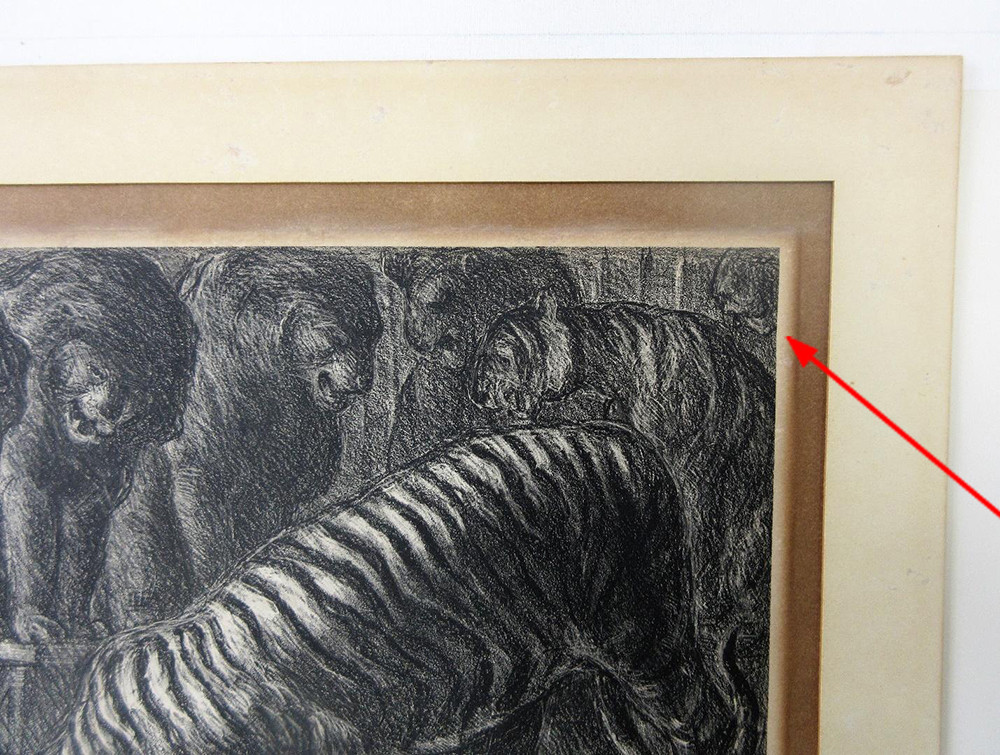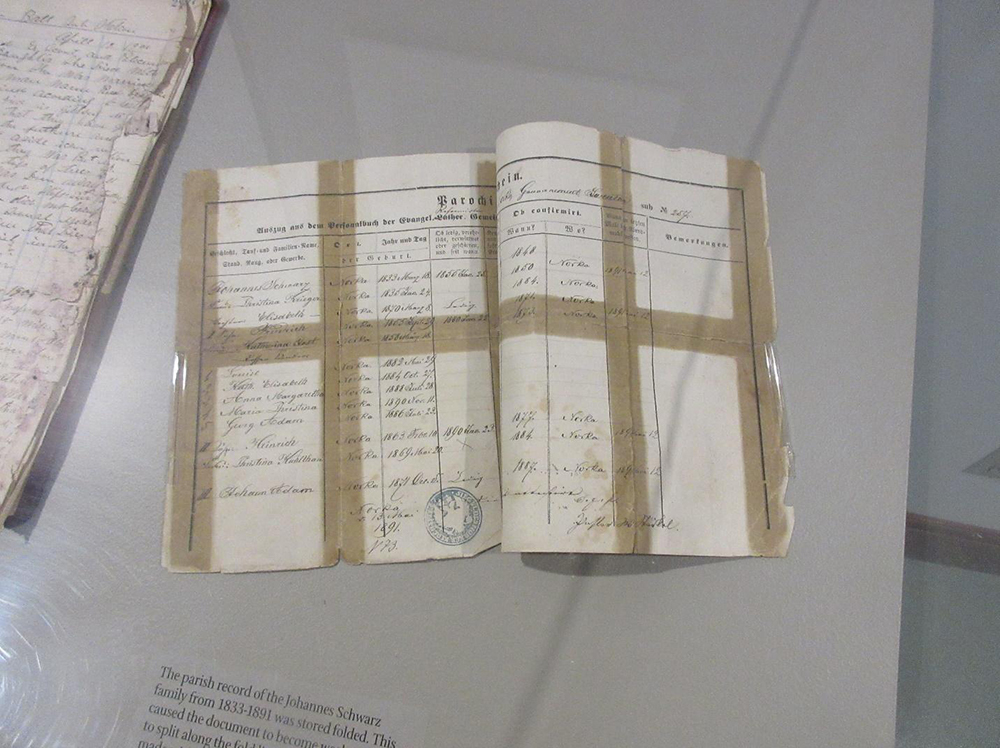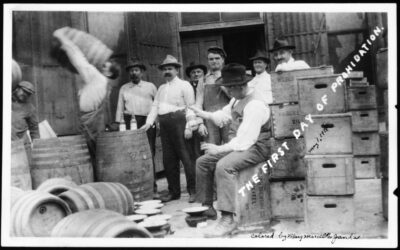At the Ford Conservation Center, we often work with documents and paper memorabilia that have been in clients’ families for years. Heirlooms like old letters, citizenship documents, and marriage certificates are passed down and become part of the family archive. Caring for these items can feel daunting, but today, conservators have easy guidelines for keeping archives of all sizes safer than ever.
Preventative care is the most important aspect of caring for your family’s archival materials. This refers to how and where items are stored and the environment. Stable environmental conditions and good storage choices are the best ways to preserve paper items.
One of people’s first concerns is how their family documents should be stored. Proper storage, also called housings, is one of the easiest solutions to preserve paper items and slow the rate of deterioration. Housings for paper items include materials such as archival boxes, folders, and protective sleeves.
The guidelines and material specifications for most paper-based archives are relatively simple. A thorough list of good (and bad) materials for storage is listed in a table at the end of this article. Many of these safe products can be ordered from non-specialized vendors, but conservation suppliers offer various sizes, shapes, and specs to house almost any type of paper item. Links to conservation suppliers can also be found at the end of this article. When shopping for storage materials, use the bold terms in the following paragraphs in your search terms.
It’s recommended to house individual photos and paper documents in clear plastic sleeves made from an inert material like polyester, polypropylene, or polyethylene. This allows for easy handling and protects the item from dust, dirt, and fingerprints. Unlike other plastics, these plastics do not discolor as they age and will not chemically alter the documents they are meant to protect. Placing paper items in sleeves made of degradable plastics results in discoloration and can make paper brittle.

Inert plastic sleeves can help separate items from one another, and protect them from dust, dirt, fingerprints, etc.
Multiple paper items of a similar size can be housed together in a labeled folder to make individual items easier to find (and limit unnecessary handling of other items). Folders come in different sizes and thicknesses, depending on their function. Most importantly, any folders used for archival storage should be acid-free or pH-neutral and lignin-free.
You’ll want to find a suitable container once you’ve sleeved and organized your documents. In addition to helping with organization, a box will protect the collection from dust, dirt, and light. Most archival boxes are made of buffered or pH-neutral materials that do not produce harmful acids as they age. Another more budget-friendly option is a plastic tote with a well-fitting lid. Just make sure that it’s made from one of the “safe” materials above – PP, PS, or PE (Recycling Code 2, 4, 5, or 6)

The bottom of this Sterilite® tote shows its recycling code (Code 5) in inside the triangular recycle symbol.
If the tote is transparent, house items in acid-free folders to protect the documents from light damage. Above all, fight the urge to reuse an old cardboard box lying around the house. Cardboard is highly acidic and will cause nearby paper items and most other organic materials to discolor and become highly brittle over time. (It’s also a good idea to make sure any framed works don’t have non-archival boards used as spacers or backings!)
Suppose an acidic material (such as cardboard or some non-archival matboards) sits in contact with a neutral material. In that case, it will “burn” the neutral material, often causing irreversible discoloration.

The light beige color next to this drawing shows the original color of the paper. It was framed with a nonarchival matboard, which produced the dark brown “halo” around it. Acid burn is typically irreversible.
The final puzzle piece is the environment where your family archive is stored. Many things can go wrong if an item is stored or displayed in the wrong environment. For example, have you ever seen a framed print in a bathroom that is wrinkled and water-damaged? This is a direct result of the significant fluctuation in humidity that occurs when a hot shower changes the environment within that room. Abrupt changes in temperature and moisture cause some of the worst damage to paper items and are often irreversible.
High-humidity areas, like basements, increase the risk of mold growth. Garages without HVAC have regular cycles of temperature spikes and drops that can quickly cause paper to expand and contract. Over a year (or many) in an uncontrolled environment, papers become brittle and damaged.
Important paper items should be stored where the temperature and relative humidity are relatively consistent without any major fluctuations. This should be a living part of the house. A cool, dark space, such as a closet, desk, or drawer, is ideal for storage boxes containing paper items. Attics and basements should be avoided whenever possible.
A good rule of thumb is that most paper is best preserved in the same environments that are comfortable for people. Relative humidity levels in the 30-55% range and temperatures below 70 degrees F are considered best for paper-based materials.

This document was exposed to temperature and humidity fluctuations, which caused curling, buckling, and rippling on the paper’s surface. The document became fragile enough that unrolling it produced cracks. Documents are often photographed under raking light to highlight any abnormalities on the surface.
Other important tips for safe storage:
- No adhesive tapes, rubber bands, or paper clips.
- Wash hands before handling to reduce oils. Gloves are not necessary for most items but are advised for handling negatives and some photos.
- Place items in boxes or totes, and store at least 4” off the ground. Bricks, two-by-fours, or other materials can be used to lift items off the floor if no shelf space is available.
- Monitor storage areas for pests that may cause damage to paper items.
- Don’t display important documents in areas with a lot of bright light. Damage caused by UV exposure is cumulative and often irreversible.

Double-sided tape or pressure-sensitive tape of any kind, such as Scotch® tape, results in staining and should not be used on original objects.

The discoloration artwork was caused by light damage. If you look closely, the thin border around the paper (the area protected by the frame) is much lighter than the rest of the page. This was the original color of the paper.
These are the basic preventive care rules that conservators, museums, and savvy individuals use to store and care for their collections properly. Contact a conservator for advice for tricky items or further help with storage needs. If you have any items that need cleaning or have been damaged, don’t hesitate to contact the Ford Conservation Center.
Conservation Materials Suppliers
Conservation Resources International: www.conservationresources.com
Gaylord Archival: www.gaylord.com
Talas: www.talasonline.com
University Products: www.universityproducts.com
Conservation Materials Quick Guide
It’s important to note that some common materials are not recommended for archival storage due to their tendency to degrade and/or contaminate nearby objects. Luckily, there are also many safe or inert materials for housing documents and other collections materials. (both everyday materials and conservation-specific products). See the table below for a list of common storage materials.
| NO (unsafe for archival storage) | YES (safe for archival storage) |
Plastics
Paper/Board Products:
Fabrics:
Other:
|
Plastics
Fabrics:
Paper/Board Products:
Other:
|




